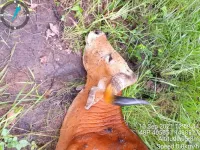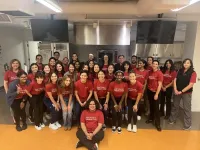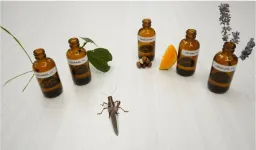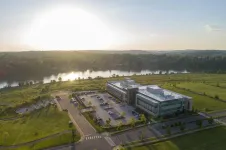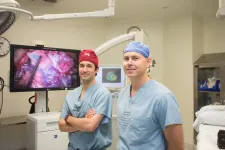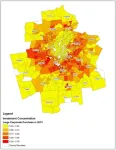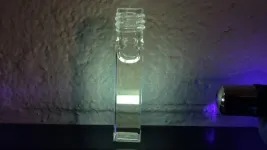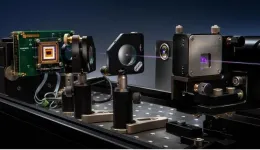(Press-News.org) Scientists from the Wildlife Conservation Society (WCS), the Ministry of Environment, and the Ministry of Agriculture Forestry and Fisheries of the Royal Government of Cambodia have documented the first case of lumpy skin disease (LSD) in wildlife in Cambodia.
The case involved a banteng (Bos javanicus), an endangered wild cattle species, that was discovered by community patrol members from Our Future Organization while on patrol in Phnom Tnout – Phnom Pork Wildlife Sanctuary in September 2021.
It is suspected that the banteng contracted the virus from infected livestock grazing nearby as the virus had already been detected in domestic cattle in the country at that time. To protect free-ranging wild bovids from LSD, a vaccination campaign was launched for domestic cattle ranging within a 20 km radius of protected areas in Mondulkiri and Preah Vihear provinces. WCS and partners published the effort this month in Frontiers in Veterinary Science.
LSD is a highly contagious viral disease that primarily affects domestic cattle and buffalo but can infect wild ruminants. The virus is transmitted through biting insects and contact with infected animals or their bodily fluids. The disease is characterized by the appearance of raised, fluid-filled bumps on the skin, fever, and other symptoms. In severe cases, LSD can be fatal. It does not infect humans.
Through this collaborative effort between veterinarians, wildlife experts, NGOs, and government officials a total of 20,089 domestic cattle and water buffalo have been vaccinated to date around banteng habitat in Cambodia.
“This vaccination campaign serves as an example of protecting both livestock and wildlife health in parallel. Cambodia is conserving wild bovids by taking practical, preventative steps in improving livestock health,” said Mr. Daro Sok, the chief of investigation, Surveillance and Control of Animal Disease for the General Directorate of Animal Health and Production.
“This joint effort to provide this providing vaccination to cattle is verymay have played a crucial roleto in preventing a larger scale disease outbreak fromin both domestic andto wild cattle, and helped protect community livelihoods and especially to halt public health risks. We thank the Royal Government of Cambodia and our partners for their support in this important effort”, said Mr. Seng Teak, Country Director of the World Wildlife Fund for Nature (WWF) Cambodia. Since the launch of the campaign, no further cases of LSD have been reported in wild banteng or in gaur (Bos gaurus), another susceptible wild cattle species.
Although LSD is a serious threat to livestock and livelihoods around the world, data are scarce on the impact on and susceptibility of wild ruminant populations. LSD is one of several diseases emerging as a direct consequence of livestock and agricultural encroachment into wildlife habitat. Targeting prevention measures towards domestic animal hosts, as was carried out around Cambodia’s protected areas, is an example of One Health in action to protect biodiversity.
The banteng was first detected and reported through Cambodia’s wildlife health surveillance network as part of the WildHealthNet initiative funded by the US Defense Threat Reduction Agency. The vaccination campaign in Cambodia was sponsored by WCS’s REDD+ initiative, Critical Ecosystem Partnership Fund, and WWF, and implemented by WCS and government partners together. WCS is working on the frontlines to reduce risk of pathogen spillover, such as African swine fever and highly pathogenic avian influenza, at livestock-wildlife interfaces across the Mekong region. Wildlife health surveillance remains ongoing in Cambodia to ensure early detection and reporting of wildlife health events across the country.
###
Wildlife Conservation Society (WCS)
WCS combines the power of its zoos and an aquarium in New York City and a Global Conservation Program in more than 50 countries to achieve its mission to save wildlife and wild places. WCS runs the world’s largest conservation field program, protecting more than 50 percent of Earth’s known biodiversity; in partnership with governments, Indigenous People, Local Communities, and the private sector. It’s four zoos and aquarium (the Bronx Zoo, Central Park Zoo, Queens Zoo, Prospect Park Zoo, and the New York Aquarium ) welcomes more than 3.5 million visitors each year, inspiring generations to care for nature. Founded in 1895 as the New York Zoological Society, the organization is led (as of June 1, 2023) by President and CEO Monica P. Medina. Visit: newsroom.wcs.org. Follow: @WCSNewsroom. For more information: +1 (347) 840-1242. Listen to the WCS Wild Audio podcast HERE.
END
Study: Vaccination campaign in Cambodia protects endangered wild cattle from highly contagious potentially fatal skin disease
Lumpy Skin Disease (LSD) is a highly contagious viral disease that primarily affects domestic cattle and buffalo but can infect wild ruminants
2023-08-08
ELSE PRESS RELEASES FROM THIS DATE:
Pipeline program at Keck School of Medicine boosts primary care residency matches and representation
2023-08-08
Primary care provides critical support for the global health care system. But in many communities across the country and around the world, primary care physicians are in short supply.
To help bridge that gap and inspire more students to choose careers in primary care, the Keck School of Medicine of USC launched its Primary Care Initiative in 2011. A key part of the initiative, the Primary Care Program (PCP), is an educational track that provides medical students with a range of patient-centered, hands-on experiences in the local community to prepare them for a career ...
Good smells, bad smells: It’s all in the insect brain
2023-08-08
Everyone has scents that naturally appeal to them, such as vanilla or coffee, and scents that don’t appeal. What makes some smells appealing and others not?
Barani Raman, a professor of biomedical engineering at the McKelvey School of Engineering at Washington University in St. Louis, and Rishabh Chandak, who earned bachelor’s, master’s and doctoral degrees in biomedical engineering in 2016, 2021 and 2022, respectively, studied the behavior of the locusts and how the neurons in their brains responded to appealing and unappealing odors to learn more about how the brain encodes ...
ORNL, UT’s Spark Cleantech Accelerator partner to support entrepreneurs
2023-08-08
Entrepreneur-fellows in Innovation Crossroads, a Department of Energy Lab-Embedded Entrepreneurship Program at Oak Ridge National Laboratory, will complete the Spark Cleantech Accelerator, a 12-week program offered by the University of Tennessee, Knoxville, Spark Innovation Center at the UT Research Park.
“By combining the resources of Innovation Crossroads and the Spark Cleantech Accelerator, we are building a stronger program for entrepreneurs,” said Dan Miller, program lead for Innovation Crossroads. “Entrepreneurial ecosystems depend on relationships among early-stage companies. This new collaboration — ...
Alfred E. Mann Charities, Inc. awards $500,000 to USC Neuro Revascularization Center
2023-08-08
The USC Neuro Revascularization Center (USC NRV Center) performs approximately 40-50 complex revascularization procedures per year, making it one of the most clinically robust programs in the country. Its multidisciplinary approach—combining plastic surgery, vascular surgery, and neurosurgery—is what allows the center to treat the most complex clinical cases and answer some of the toughest research questions.
A recent $500,000 gift from Alfred E. Mann Charities will support clinical excellence, novel research, and educational opportunities at the center with a clear focus ...
Opioids, methadone and babies
2023-08-08
LOS ANGELES (August 8, 2023) — Whatever the opioid crisis calls to mind, it likely isn’t pacifiers and diapers. But when 1 out of every 5 hospitalized infants receives opioids, and when some infants require methadone treatment, it’s time to widen the scope. A new study led by pediatric surgeons at Children’s Hospital Los Angeles shows that methadone use after surgery can prolong a baby’s recovery and increase an infant’s dependence on ventilators and intravenous (IV) nutrition.
To call the opioid problem in the United States a crisis is not hyperbole. The rate of death due to opioid overdose has risen ...
Investors force Black families out of home ownership, new research shows
2023-08-08
Investors have been buying houses at a steady rate since the last recession, but how much does it affect availability in the housing market? New research from the Georgia Institute of Technology shows investors are most likely to push out Black, middle-class homeowners from neighborhoods.
Data from 800 neighborhoods in the Atlanta metropolitan area between 2007 and 2016 revealed that major investors bought homes in majority-minority neighborhoods far from downtowns and in lower-income areas. These homes were often undervalued because of their minority populations, but they remained desirable and offered good market value.
The neighborhoods ...
Cybersecurity project plans to connect researchers across the country
2023-08-08
From building fighter jets to automobiles, the manufacturing world is increasingly adapting digital instruction as technology advances. Mechanical parts can be designed on a computer and shipped over the network to a manufacturing machine that follows digital instructions to produce a specific part. The move into the digital world makes securing online information a national interest.
Dr. Narasimha Reddy, a professor in the Department of Electrical and Computer Engineering at Texas A&M University, recently received a National Science Foundation grant to research cybersecurity ...
The “unknome”: a database of human genes we know almost nothing about
2023-08-08
Researchers from the United Kingdom hope that a new, publicly available database they have created will shrink, not grow, over time. That’s because it is a compendium of the thousands of understudied proteins encoded by genes in the human genome, whose existence is known but whose functions are mostly not. The database, dubbed the “unknome”, is the work of Matthew Freeman of the Dunn School of Pathology, University of Oxford, England, and Sean Munro of MRC Laboratory of Molecular Biology in Cambridge, England, and ...
Texas A&M's McKay receives NSF CAREER Award
2023-08-08
Dissolved organic matter (DOM) can be found in every water body on Earth, encompassing both saltwater and freshwater. It is a significant carbon source and is critical in environmental carbon cycling, which is the circulation of carbon in various forms through the environment and nature that makes the Earth sustainable for life.
The interaction between DOM and sunlight is essential for the carbon cycle to function effectively. However, the chemical structure of light-absorbing compounds, also known as chromophores, in DOM remains limited.
Dr. Garrett McKay, principal investigator of the Aquatic Chemistry Lab and assistant professor ...
Researchers use SPAD detector to achieve 3D quantum ghost imaging
2023-08-08
WASHINGTON — Researchers have reported the first 3D measurements acquired with quantum ghost imaging. The new technique enables 3D imaging on a single photon level, yielding the lowest photon dose possible for any measurement.
“3D imaging with single photons could be used for various biomedical applications, such as eye care diagnostics,” said researcher Carsten Pitsch from the Fraunhofer Institute of Optronics, System Technologies and Image Exploitation and Karlsruhe Institute of Technology, both in Germany. “It can be applied to image materials and tissues that are sensitive to light or drugs that become toxic when exposed ...
LAST 30 PRESS RELEASES:
How do childcare tax credits affect children’s long-term health?
Can an electronic nose detect indoor mold?
Do natural disasters have long-term impacts on mortality in older adults?
Modification improves sodium‐ion batteries as an alternative to lithium-ion batteries
Parasports provide a range of benefits for people with cerebral palsy
How does grandparental care affect children’s health?
Why are there so many Nordic mediators?
Young shark species more vulnerable to extinction
Mobile fetal heart monitoring linked to fewer newborn deaths in Tanzania
Bluey’s dad offered professorial chair in archaeology at Griffith University
Beyond small data limitations: Transfer learning-enabled framework for predicting mechanical properties of aluminum matrix composites
Unveiling non-thermal catalytic origin of direct current-promoted catalysis for energy-efficient transformation of greenhouse gases to valuable chemicals
Chronic breathlessness emerging as a hidden strain on hospitals
Paleontologists find first fossil bee nests made inside fossil bones
These fossils were the perfect home for ancient baby bees
Not everyone reads the room the same. A new study examines why.
New research identifies linked energy, immune and vascular changes in ME/CFS
Concurrent frailty + depression likely boost dementia risk in older people
Living in substandard housing linked to kids’ missed schooling and poor grades
Little awareness of medical + psychological complexities of steroid cream withdrawal
Eight in 10 trusts caring for emergency department patients in corridors, finds BMJ investigation
NASA’s Webb telescope finds bizarre atmosphere on a lemon-shaped exoplanet
The gut bacteria that put the brakes on weight gain in mice
Exploring how patients feel about AI transcription
Category ‘6’ tropical cyclone hot spots are growing
Video: Drivers struggle to multitask when using dashboard touch screens, study finds
SLU research shows surge in alcohol-related liver disease driving ‘deaths of despair’
Rising heat reshapes how microbes break down microplastics, new review finds
Roots reveal a hidden carbon pathway in maize plants
Membrane magic: FAMU-FSU researchers repurpose fuel cells membranes for new applications
[Press-News.org] Study: Vaccination campaign in Cambodia protects endangered wild cattle from highly contagious potentially fatal skin diseaseLumpy Skin Disease (LSD) is a highly contagious viral disease that primarily affects domestic cattle and buffalo but can infect wild ruminants
